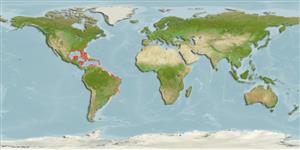Polyplacophora |
Chitonida |
Chitonidae
Environment: milieu / climate zone / depth range / distribution range
Ecology
Benthic; depth range 0 - 49 m (Ref. 2022). Tropical
Western Central Atlantic: USA, Colombia, Bermuda and the West Indies.
Length at first maturity / Size / Weight / Age
Maturity: Lm ? range ? - ? cm Max length : 2.5 cm TL male/unsexed; (Ref. 281)
Valves color: Brownish red to buff with darker mottlings and speckles. Surface of valves: Glossy. Lateral area: Separated from the smooth central area by a strong, rounded rib. Central area: Peppering of black eyes. Girdle: appears naked, leathery and brownish to flesh colored (Ref. 281).
Maximum depth from Ref. 110502. On carbonate environments such as reefs and coralline sands. Epibiotic (Ref. 110502).
Life cycle and mating behavior
Maturity | Reproduction | Spawning | Eggs | Fecundity | Larvae
Members of the class Polyplacophora are mostly gonochoric. Life cycle: Eggs hatch into lecitotrophic planktonic trocophore larvae (no veliger stage) which later metamorphose and settle on the bottom as young adults.
Burghardt, G. and L. Burghardt 2006 Selected Chitons of Caribbean Area and the East Coast of United States and Canada. A Gallery of Worlwide Chitons: http://home.inreach.com/burghart/eastcoas.html[accessed20/01/06] (Ref. 281)
IUCN Red List Status
(Ref. 130435: Version 2025-1)
CITES status (Ref. 108899)
Not Evaluated
Not Evaluated
Threat to humans
Human uses
| FishSource |
Tools
More information
Trophic EcologyFood items (preys)
Diet composition
Food consumption
Predators
Population dynamicsGrowth
Max. ages / sizes
Length-weight rel.
Length-length rel.
Length-frequencies
Mass conversion
Abundance
Life cycleReproductionMaturityFecunditySpawningEggsEgg developmentLarvae PhysiologyOxygen consumption
Human RelatedStamps, coins, misc.
Internet sources
Estimates based on models
Preferred temperature
(Ref.
115969): 23.5 - 28, mean 26.5 (based on 222 cells).
Fishing Vulnerability
Low vulnerability (10 of 100).
Price category
Unknown.
